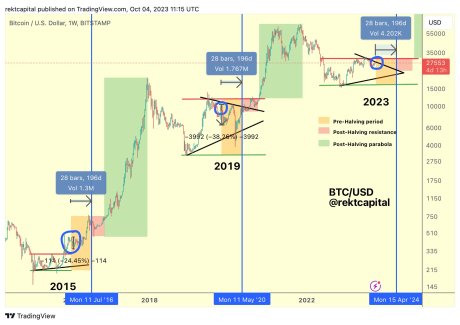Btc Halving
If these are the Characteristics of an Early Bitcoin Bullrun, When Can we Expect the Cycle’s Peak? – Blockchain News, Opinion, TV and Jobs
Published
1 month agoon
By
admin
By Matteo Greco, Research Analyst at the publicly listed digital asset and fintech investment business Fineqia International
Bitcoin (BTC) ended the week at approximately $68,400, showing a slight 0.8% decrease from the previous week’s closing value of around $69,000. Throughout the week, BTC displayed significant volatility, with a price range of 13.4%. The week commenced with robust momentum as BTC surged to $72,000 on Monday. Subsequently, the price reached a new all-time high of nearly $73,800 on Thursday, following peaks of over $73,000 on both Wednesday and Thursday.
On the same Thursday, BTC experienced a sharp decline to $68,000 before rebounding to close around $71,400. On Friday and Saturday, selling pressure persisted, driving BTC to trade as low as $64,700 and closing Saturday near $65,300. However, positive momentum returned on Sunday, nearly recovering the weekly loss and closing around $68,400.
Despite the volatility and fluctuating prices, the previous week demonstrated continued strong momentum for BTC Spot ETFs, with net inflows recorded on all trading days. The weekly net inflow surpassed $2.5 billion, with Tuesday alone witnessing a net inflow of over $1 billion. The cumulative net inflow since inception now stands at approximately $12.2 billion.
Trading volume for BTC Spot ETFs also witnessed an upward trend, with total trading volume reaching $141.7 billion since inception, including nearly $28 billion traded in the last week. This translated to a daily trading volume exceeding $5.5 billion during the previous week, contributing to a higher average daily volume since inception, currently standing at approximately $3.15 billion.
These figures underscore the sustained momentum of investments from traditional finance into the digital assets space. Despite BTC’s price stability last week, the demand primarily stems from ETFs, while native digital assets investors are more active on the selling side.
This trend is evident in the decrease of BTC held by long-term holders, referring to BTC that remained unmoved for at least 155 days. At the beginning of 2024, this supply was nearly 16.3 million BTC, gradually decreasing to about 15.1 million BTC as now. This shift reflects traditional investors driving buying activity through ETFs, while native digital assets investors, who accumulated during the downtrend in 2022 and 2023, are now profit-taking at a higher rate, reducing long-term holder supply.
Such behaviour is characteristic of early bull phases, where long-term holders distribute assets to new investors. If the current market remains in an uptrend, analysing the past cycles, this pattern could persist until the supply from long-term holders matches the demand from new investors, which usually coincides with the cycle’s peak and the beginning of a downtrend phase.
Notably, the BTC halving is approximately one month away, historically preceding cycle peaks between 6 and 12 months later. If historical patterns repeat, the current cycle’s peak could occur in late 2024 or the first half of 2025.
Source link
You may like


Bitcoin Just Entered a ‘Second Danger Zone,’ Warns Crypto Analyst – Here Are His Targets


Forbes Unveils 20 Crypto ‘Zombies,’ Declares Ripple And XRP Among The Undead


Crypto Trader Issues Bitcoin Warning, Says Ethereum Liquid Staking Project Flashing Short-Term Bullish Signal


Crypto Analyst Predicts Massive Move For Bitcoin, What’s The Target?


Analyst Warns One Crypto Asset Category About To Face a Reckoning, Maps Path Forward for Bitcoin and Hedera


DOGE Price Prediction – Dogecoin Below $0.14 Could Spark Larger Degree Drop
Btc Halving
Bullish March Marks Record for Bitcoin – Blockchain News, Opinion, TV and Jobs
Published
2 days agoon
April 25, 2024By
admin
By Matteo Greco, Research Analyst at the publicly listed digital asset and fintech investment business Fineqia International
Bitcoin (BTC) concluded the month of March at approximately $71,300, marking a 16.6% increase from the previous month’s closing value of around $61,150. This monthly surge represents a historic milestone for BTC price action. March witnessed the seventh consecutive month of price growth for BTC, a first since its inception.
The sustained price appreciation began in Q4 2023, as market participants anticipated a high probability of BTC Spot ETFs approval in January. This anticipation was followed by the actual approval of BTC Spot ETFs in early January 2024. Throughout Q1, BTC surged from $42,300 at the beginning of the year to approximately $71,300, reflecting a 64.7% increase in price. However, in the first few days of April, BTC witnessed a decline, with the price hovering around $66,500 at the time of this writing.
The recent price growth is primarily fuelled by demand for BTC Spot ETFs, which have accumulated over $12 billion in net inflows since their inception. Last week, BTC Spot ETFs saw approximately $850 million in net inflows, followed by $85 million in outflows on April 1st and $40 million in inflows on April 2nd.
While there is still strong overall net inflow in BTC Spot ETFs, there is also evidence of reduced sustained demand and some profit-taking, leading to a slower pace of cumulative inflows compared to previous months. This is to be expected, considering that the majority of BTC Spot ETF investors are already in profit, given that BTC was priced between $40,000 and $45,000 at the time of their launch.
The upcoming BTC halving event, currently expected for April 20th, just seventeen days away, will halve block rewards for miners from 6.25 to 3.125 BTC, potentially impacting mining companies. With BTC block rewards decreasing and the BTC hashrate consistently rising over the past few years, the profitability of mining farms has steadily declined, necessitating greater capital efficiency to remain viable.
This dynamic compels mining companies to optimize capital efficiency and seek cheaper electricity sources, leading to an increasing use of renewable energy in BTC mining. The BTC mining rewards mechanism inherently drives greater efficiency with each step, enhancing network security, reducing carbon emissions, and promoting research into sustainable block confirmation methods.
Historically, BTC halving events have marked significant points followed by 9-18 months of uptrend, culminating in cycle peaks. However, for the first time, BTC reached its all-time high in anticipation of the halving, indicating a departure from previous cycles. If historical patterns repeat, we may witness an uptrend for the remaining nine months of 2024, leading to a cycle peak expected between Q4 2024 and Q2 2025.
Source link
Btc Halving
Bullish March Marks Record for Bitcoin – Blockchain News, Opinion, TV and Jobs
Published
1 week agoon
April 20, 2024By
admin
By Matteo Greco, Research Analyst at the publicly listed digital asset and fintech investment business Fineqia International
Bitcoin (BTC) concluded the month of March at approximately $71,300, marking a 16.6% increase from the previous month’s closing value of around $61,150. This monthly surge represents a historic milestone for BTC price action. March witnessed the seventh consecutive month of price growth for BTC, a first since its inception.
The sustained price appreciation began in Q4 2023, as market participants anticipated a high probability of BTC Spot ETFs approval in January. This anticipation was followed by the actual approval of BTC Spot ETFs in early January 2024. Throughout Q1, BTC surged from $42,300 at the beginning of the year to approximately $71,300, reflecting a 64.7% increase in price. However, in the first few days of April, BTC witnessed a decline, with the price hovering around $66,500 at the time of this writing.
The recent price growth is primarily fuelled by demand for BTC Spot ETFs, which have accumulated over $12 billion in net inflows since their inception. Last week, BTC Spot ETFs saw approximately $850 million in net inflows, followed by $85 million in outflows on April 1st and $40 million in inflows on April 2nd.
While there is still strong overall net inflow in BTC Spot ETFs, there is also evidence of reduced sustained demand and some profit-taking, leading to a slower pace of cumulative inflows compared to previous months. This is to be expected, considering that the majority of BTC Spot ETF investors are already in profit, given that BTC was priced between $40,000 and $45,000 at the time of their launch.
The upcoming BTC halving event, currently expected for April 20th, just seventeen days away, will halve block rewards for miners from 6.25 to 3.125 BTC, potentially impacting mining companies. With BTC block rewards decreasing and the BTC hashrate consistently rising over the past few years, the profitability of mining farms has steadily declined, necessitating greater capital efficiency to remain viable.
This dynamic compels mining companies to optimize capital efficiency and seek cheaper electricity sources, leading to an increasing use of renewable energy in BTC mining. The BTC mining rewards mechanism inherently drives greater efficiency with each step, enhancing network security, reducing carbon emissions, and promoting research into sustainable block confirmation methods.
Historically, BTC halving events have marked significant points followed by 9-18 months of uptrend, culminating in cycle peaks. However, for the first time, BTC reached its all-time high in anticipation of the halving, indicating a departure from previous cycles. If historical patterns repeat, we may witness an uptrend for the remaining nine months of 2024, leading to a cycle peak expected between Q4 2024 and Q2 2025.
Source link
Bitcoin
What To Expect If Historical Bitcoin Halving Cycles Repeat
Published
7 months agoon
October 14, 2023By
admin
It’s been quite a bearish week for Bitcoin, as the crypto has fallen around 3% since the beginning of the week. Price action, in particular, has had Bitcoin struggling to break above $27,000, indicating a potential risk of more losses below this resistance level in the near term.
However, according to a crypto analyst, this current retracement might be the beginning of a historical Bitcoin cycle before each halving.
Analyst Shows Bitcoin Price Correction Based On Historical Trends
Crypto analyst Rekt Capital has said in a post that if historical Bitcoin “halving cycles” are any indication, a major price correction could be right around the corner. The Bitcoin halving cuts the block reward for miners in half.
This happens roughly every 4 years to slow the creation of new BTC and control inflation. Based on historical data from the previous two Bitcoin halvings, the price of BTC could drop by up to 38% before the next halving.
In a chart shared on X (formerly Twitter), Rekt Capital showed a major pull back has happened around six months before each halving. In the 2015 cycle, BTC retraced 25% 196 days before the 2016 halving.
In 2019, BTC retraced 38%, 196 days before the 2020 halving. So with the next halving slated to occur around April 2024, it would seem the market is now in a prime position for the next correction.

Previous halving trends | Source: X
Bitcoin is currently 60% below its all-time high, following a similar pattern with past halvings. 200 days before the 2020 halving, BTC was 60% below its all-time high. Likewise, 200 days before the 2016 halving, BTC was 65% below its all-time high.
What A Correction Would Mean For BTC
Bitcoin’s price direction is currently uncertain, especially as on-chain transactions on the blockchain are now at a three-month low. On-chain metrics have shown that 95% of Bitcoin’s circulating supply hasn’t changed hands in the past month, as investors seem to be holding on to the cryptocurrency in anticipation of the SEC’s approval of spot Bitcoin ETFs.
Although past performance doesn’t always repeat, if this pattern shows up again before the next halving, Bitcoin could be in for a big correction. With the current price of BTC now at $26,770, a 38% retracement could see BTC fall below $18,000. If this happens, it would be devastating for BTC holders.
Even though a price correction may be on the horizon, Bitcoin’s long-term growth prospects remain strong. Over the past decade, Bitcoin has shown a consistent upward trend as the largest crypto by market cap despite facing several setbacks.
Bitcoin has been named the best performer this year in terms of asset investing by Reflexivity, a digital asset research firm. According to billionaire hedge fund manager Paul Tudor Jones, this is the best time to buy BTC.
BTC price at $26,782 | Source: BTCUSD on Tradingview.com
Featured image from Asia Crypto Today, chart from Tradingview.com
Source link

Bitcoin Just Entered a ‘Second Danger Zone,’ Warns Crypto Analyst – Here Are His Targets

Forbes Unveils 20 Crypto ‘Zombies,’ Declares Ripple And XRP Among The Undead

Crypto Trader Issues Bitcoin Warning, Says Ethereum Liquid Staking Project Flashing Short-Term Bullish Signal

Crypto Analyst Predicts Massive Move For Bitcoin, What’s The Target?

Analyst Warns One Crypto Asset Category About To Face a Reckoning, Maps Path Forward for Bitcoin and Hedera

DOGE Price Prediction – Dogecoin Below $0.14 Could Spark Larger Degree Drop

WhalesNight AfterParty 2024 – Blockchain News, Opinion, TV and Jobs

‘Violent to the Upside’: This Catalyst Could See Bitcoin Explode by up to 1,486%, Says Strike CEO Jack Mallers

85% Of Altcoins In “Opportunity Zone,” Santiment Reveals

Ethereum, Solana and Altcoins Approaching ‘Banana Zone,’ According to Macro Guru Raoul Pal – Here’s His Outlook

Bullish March Marks Record for Bitcoin – Blockchain News, Opinion, TV and Jobs

Why Is The Dogecoin Price Down Today?

The AI-Based Smart Contract Audit Firm “Bunzz Audit” Has Officially Launched – Blockchain News, Opinion, TV and Jobs
Successful Beta Service launch of SOMESING, ‘My Hand-Carry Studio Karaoke App’

dWallet Network brings multi-chain DeFi to Sui, featuring native Bitcoin and Ethereum – Blockchain News, Opinion, TV and Jobs

Bitcoin Dropped Below 2017 All-Time-High but Could Sellers be Getting Exhausted? – Blockchain News, Opinion, TV and Jobs

What does the Coinbase Premium Gap Tell us about Investor Activity? – Blockchain News, Opinion, TV and Jobs
BNM DAO Token Airdrop

NFT Sector Keeps Developing – Number of Unique Ethereum NFT Traders Surged 276% in 2022 – Blockchain News, Opinion, TV and Jobs
New Minting Services

Block News Media Live Stream
A String of 200 ‘Sleeping Bitcoins’ From 2010 Worth $4.27 Million Moved on Friday

SEC’s Chairman Gensler Takes Aggressive Stance on Tokens – Blockchain News, Opinion, TV and Jobs

Friends or Enemies? – Blockchain News, Opinion, TV and Jobs

Enjoy frictionless crypto purchases with Apple Pay and Google Pay | by Jim | @blockchain | Jun, 2022

Block News Media Live Stream

Block News Media Live Stream

How Web3 can prevent Hollywood strikes

XRP Explodes With 1,300% Surge In Trading Volume As crypto Exchanges Jump On Board

Block News Media Live Stream
Trending

 Altcoins2 years ago
Altcoins2 years agoBitcoin Dropped Below 2017 All-Time-High but Could Sellers be Getting Exhausted? – Blockchain News, Opinion, TV and Jobs

 Binance2 years ago
Binance2 years agoWhat does the Coinbase Premium Gap Tell us about Investor Activity? – Blockchain News, Opinion, TV and Jobs
- Uncategorized2 years ago
BNM DAO Token Airdrop

 BTC1 year ago
BTC1 year agoNFT Sector Keeps Developing – Number of Unique Ethereum NFT Traders Surged 276% in 2022 – Blockchain News, Opinion, TV and Jobs
- Uncategorized2 years ago
New Minting Services

 Video1 year ago
Video1 year agoBlock News Media Live Stream

 Bitcoin miners2 years ago
Bitcoin miners2 years agoA String of 200 ‘Sleeping Bitcoins’ From 2010 Worth $4.27 Million Moved on Friday

 Bitcoin1 year ago
Bitcoin1 year agoSEC’s Chairman Gensler Takes Aggressive Stance on Tokens – Blockchain News, Opinion, TV and Jobs

